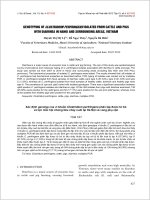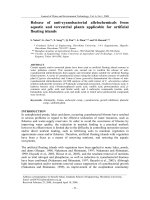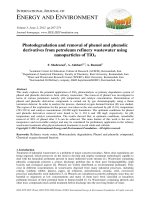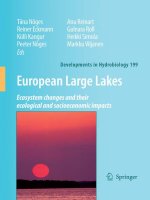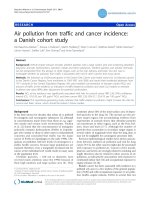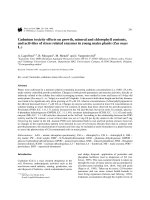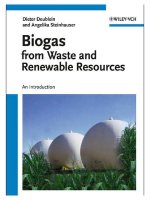Mixture toxicity linking approaches from ecological and human toxicology society of environmental toxicology and chemistry setac
Bạn đang xem bản rút gọn của tài liệu. Xem và tải ngay bản đầy đủ của tài liệu tại đây (5.46 MB, 302 trang )
Mixture
Toxicity
Linking Approaches from
Ecological and Human Toxicology
Other Titles from the Society of Environmental Toxicology and
Chemistry (SETAC)
Ecotoxicology of Amphibians and Reptiles
Sparling, Linder, Bishop, Krest, editors
2010
Ecological Assessment of Selenium in the Aquatic Environment
Chapman, Adams, Brooks, Delos, Luoma, Maher, Ohlendorf, Presser, Shaw, editors
2010
Application of Uncertainty Analysis to Ecological Risks of Pesticides
Warren-Hicks and Hart, editors
2010
Risk Assessment Tools Software and User’s Guide
Mayer, Ellersieck, Asfaw
2009
Derivation and Use of Environmental Quality and Human Health Standards for Chemical
Substances in Water and Soil
Crane, Matthiessen, Maycock, Merrington, Whitehouse, editors
2009
Linking Aquatic Exposure and Effects: Risk Assessment of Pesticides
Brock, Alix, Brown, Capri, Gottesbüren, Heimbach, Lythgo, Schulz, Streloke, editors
2009
Aquatic Macrophyte Risk Assessment for Pesticides
Maltby, Arnold, Arts, Davies, Heimbach, Pickl, Poulsen
2009
Ecological Models for Regulatory Risk Assessments of Pesticides:
Developing a Strategy for the Future
Thorbek, Forbes, Heimbach, Hommen, Thulke, Van den Brink, Wogram, Grimm, editors
2009
Linking Aquatic Exposure and Effects: Risk Assessment of Pesticides
Brock, Alix, Brown, Capri, Gottesbüren, Heimbach, Lythgo, Schulz, Streloke, editors
2009
For information about SETAC publications, including SETAC’s international journals,
Environmental Toxicology and Chemistry and Integrated Environmental Assessment and
Management, contact the SETAC office nearest you:
SETAC
1010 North 12th Avenue
Pensacola, FL 32501-3367 USA
T 850 469 1500 F 850 469 9778
E
SETAC Office
Avenue de la Toison d’Or 67
B-1060 Brussells, Belguim
T 32 2 772 72 81 F 32 2 770 53 86
E
www.setac.org
Environmental Quality Through Science®
Mixture
Toxicity
Linking Approaches from
Ecological and Human Toxicology
Edited by
Cornelis A.M. van Gestel
Martijs J. Jonker
Jan E. Kammenga
Ryszard Laskowski
Claus Svendsen
Coordinating Editor of SETAC Books
Joseph W. Gorsuch
Copper Development Association, Inc.
New York, NY, USA
Boca Raton London New York
CRC Press is an imprint of the
Taylor & Francis Group, an informa business
CRC Press
Taylor & Francis Group
6000 Broken Sound Parkway NW, Suite 300
Boca Raton, FL 33487-2742
© 2011 by Taylor and Francis Group, LLC
CRC Press is an imprint of Taylor & Francis Group, an Informa business
No claim to original U.S. Government works
Printed in the United States of America on acid-free paper
10 9 8 7 6 5 4 3 2 1
International Standard Book Number: 978-1-4398-3008-6 (Hardback)
This book contains information obtained from authentic and highly regarded sources. Reasonable efforts
have been made to publish reliable data and information, but the author and publisher cannot assume
responsibility for the validity of all materials or the consequences of their use. The authors and publishers
have attempted to trace the copyright holders of all material reproduced in this publication and apologize to
copyright holders if permission to publish in this form has not been obtained. If any copyright material has
not been acknowledged please write and let us know so we may rectify in any future reprint.
Except as permitted under U.S. Copyright Law, no part of this book may be reprinted, reproduced, transmitted, or utilized in any form by any electronic, mechanical, or other means, now known or hereafter invented,
including photocopying, microfilming, and recording, or in any information storage or retrieval system,
without written permission from the publishers.
For permission to photocopy or use material electronically from this work, please access www.copyright.
com ( or contact the Copyright Clearance Center, Inc. (CCC), 222 Rosewood
Drive, Danvers, MA 01923, 978-750-8400. CCC is a not-for-profit organization that provides licenses and
registration for a variety of users. For organizations that have been granted a photocopy license by the CCC,
a separate system of payment has been arranged.
Trademark Notice: Product or corporate names may be trademarks or registered trademarks, and are used
only for identification and explanation without intent to infringe.
Library of Congress Cataloging‑in‑Publication Data
Mixture toxicity : linking approaches from ecological and human toxicology / editors,
Cornelis A. M. van Gestel … [et al.].
p. cm.
Includes bibliographical references and index.
ISBN 978-1-4398-3008-6 (hardcover : alk. paper)
1. Environmental toxicology. 2. Mixtures--Toxicology. 3. Environmental risk
assessment. I. Gestel, Cornelis A. M. van.
RA1226.M59 2011
615.9’02--dc22
Visit the Taylor & Francis Web site at
and the CRC Press Web site at
2010032498
SETAC Publications
Books published by the Society of Environmental Toxicology and Chemistry
(SETAC) provide in-depth reviews and critical appraisals on scientific subjects relevant to understanding the impacts of chemicals and technology on the environment.
The books explore topics reviewed and recommended by the Publications Advisory
Council and approved by the SETAC North America, Latin America, or Asia/Pacific
Board of Directors; the SETAC Europe Council; or the SETAC World Council for
their importance, timeliness, and contribution to multidisciplinary approaches to
solving environmental problems. The diversity and breadth of subjects covered in
the series reflect the wide range of disciplines encompassed by environmental toxicology, environmental chemistry, hazard and risk assessment, and life-cycle assessment. SETAC books attempt to present the reader with authoritative coverage of the
literature, as well as paradigms, methodologies, and controversies; research needs;
and new developments specific to the featured topics. The books are generally peer
reviewed for SETAC by acknowledged experts.
SETAC publications, which include Technical Issue Papers (TIPs), workshop summaries, newsletter (SETAC Globe), and journals (Environmental Toxicology and
Chemistry and Integrated Environmental Assessment and Management), are useful
to environmental scientists in research, research management, chemical manufacturing and regulation, risk assessment, and education, as well as to students considering or preparing for careers in these areas. The publications provide information
for keeping abreast of recent developments in familiar subject areas and for rapid
introduction to principles and approaches in new subject areas.
SETAC recognizes and thanks the past coordinating editors of SETAC books:
A.S. Green, International Zinc Association
Durham, North Carolina, USA
C.G. Ingersoll, Columbia Environmental Research Center
US Geological Survey, Columbia, Missouri, USA
T.W. La Point, Institute of Applied Sciences
University of North Texas, Denton, Texas, USA
B.T. Walton, US Environmental Protection Agency
Research Triangle Park, North Carolina, USA
C.H. Ward, Department of Environmental Sciences and Engineering
Rice University, Houston, Texas, USA
Contents
List of Figures............................................................................................................ix
List of Tables........................................................................................................... xiii
Preface...................................................................................................................... xv
General Introduction...............................................................................................xvii
About the Editors.....................................................................................................xix
Workshop Participants.......................................................................................... xxiii
Executive Summary..............................................................................................xxvii
Chapter 1 Exposure................................................................................................1
David J. Spurgeon, Hana R. Pohl, Susana Loureiro,
Hans Løkke, and Cornelis A. M. van Gestel
Chapter 2 Toxicokinetics and Toxicodynamics................................................... 47
Claus Svendsen, Tjalling Jager, Sami Haddad,
Raymond S. H. Yang, Jean Lou C. M. Dorne, Mieke Broerse,
and Paulina Kramarz
Chapter 3 Toxicity from Combined Exposure to Chemicals............................... 95
Andreas Kortenkamp and Rolf Altenburger
Chapter 4 Test Design, Mixture Characterization, and Data Evaluation.......... 121
Martijs J. Jonker, Almut Gerhardt, Thomas Backhaus, and
Cornelis A. M. van Gestel
Chapter 5 Human and Ecological Risk Assessment of Chemical Mixtures..... 157
Ad M. J. Ragas, Linda K. Teuschler, Leo Posthuma, and
Christina E. Cowan
Appendix 1: Uncertainty of Concentration and Response Addition................ 213
Glossary................................................................................................................. 217
References.............................................................................................................. 229
Index....................................................................................................................... 271
vii
List of Figures
Figure 1 Venue of the SETAC-NoMiracle workshop in Krakow, 2–6 April,
2006.........................................................................................................................xvi
Figure 1.1 The continuum of multimedia fate models available for
estimating overall persistence (Pov) and potential for long-range transport of
chemicals.................................................................................................................. 22
Figure 1.2 Exposures in life stages....................................................................... 29
Figure 2.1 Hypothetical scheme for toxicokinetics and toxicodynamics for
a mixture of 2 components....................................................................................... 50
Figure 2.2 Development of body concentrations for 2 chemicals having
different toxicokinetics, leading to an internal mixture composition that
varies with time and differs from the external mixture ........................................... 54
Figure 2.3 An example of a data-based toxicokinetic model, in this case a
1-compartment model............................................................................................... 56
Figure 2.4 A typical conceptual representation of a PBTK model for a
volatile organic chemical A...................................................................................... 58
Figure 2.5 Interactions between n-hexane and its metabolites . ..........................64
Figure 2.6 A representation of a network of binary toxicokinetic
interactions between 5 chemicals............................................................................. 65
Figure 2.7 Representation of the PBTK model developed for a mixture of 5
VOCs (m-xylene, toluene, ethylbenzene, benzene, and dichloromethane)............... 67
Figure 2.8 Simulations of venous blood concentrations of toluene and
ethylbenzene when maximal impact of inhibition and maximal impact of
induction are considered in rats exposed for a duration of 4 hours at 100 ppm....... 68
Figure 2.9 Schematic representation of the multicomponent damage
assessment model of Lee and Landrum .................................................................. 72
Figure 2.10 Two approaches for dynamic survival analysis................................. 78
Figure 2.11 Schematic representation of a dynamic energy budget model..........80
Figure 2.12 A conceptual physiologically based pharmacodynamic (PBTD)
model for CCl4 and kepone interaction . .................................................................. 82
Figure 2.13 A simple 2-stage model of carcinogenesis........................................ 83
ix
x
List of Figures
Figure 2.14 Example of the fit of a stochastic model to the effects of a
mixture of copper and cadmium on the survival of the springtail Folsomia
candida..................................................................................................................... 86
Figure 3.1 Combined effects of a combination of 7 anticancer drugs with
different sites of action .......................................................................................... 100
Figure 3.2 Observed and predicted algal toxicity of a mixture of 16
dissimilar acting substances................................................................................... 101
Figure 3.3 Observed and predicted algal toxicity of a mixture of 14
nitrobenzenes.......................................................................................................... 102
Figure 3.4 Illustration of a “sham” mixture experiment with chemicals that
all exhibit the same dose–response curve .............................................................. 109
Figure 4.1 Examples of possible designs for determining the toxicity of
binary mixtures, including the single chemicals as well as covering the entire
concentration–response surface . ........................................................................... 136
Figure 4.2 Two-step prediction model combining concentration addition
(CA) and independent action (IA) models to predict the toxicity of a complex
mixture of 10 chemicals ........................................................................................ 148
Figure 4.3 Approach to complex mixture toxicity analysis that might be
used for the top-down approach ............................................................................ 149
Figure 4.4 Strategy for evaluating the mutagenicity of complex mixtures
applying pattern recognition .................................................................................. 150
Figure 5.1 Risk assessment is traditionally organized in a series of
consecutive steps—1) hazard identification, 2) exposure assessment, 3) effect
assessment, and 4) risk characterization—and generally embedded in a wider
framework involving research, problem formulation, risk management, and
action . .................................................................................................................... 160
Figure 5.2 Overview of the issues that must be considered in mixture
assessment in addition to those for single chemicals . ........................................... 161
Figure 5.3 Three alternative options to assess the risk of mixtures:
1) mixtures can be tested in the field or the laboratory, particularly
completely unknown mixtures; 2) if toxicity data on (sufficient) similar
mixtures are available, the mixture can be evaluated using a reference value,
for example, in a PEC/PNEC ratio; and 3) mixtures of which the components
are known can be evaluated using component-based approaches (mixture
algorithms) ............................................................................................................. 162
Figure 5.4 Flowchart showing various human risk assessment options for a
chemical mixture based on whole mixture data . .................................................. 166
Figure 5.5 Flowchart showing various human risk assessment options for
chemical mixtures based on component data ........................................................ 167
List of Figures
xi
Figure 5.6 An example of a spatially explicit monitoring of mixture risks ...... 175
Figure 5.7 Weight-of-evidence (WOE) approach in assessing mixture
effects ...................................................................................................................177
Figure 5.8 Interpretation of the concept of (acute) toxic pressure
(multisubstance probably affected fraction of species (msPAF), based on
species sensitivity distributions (SSDs) made from EC50s) using fish species
census data from a large monitoring data set......................................................... 180
Figure 5.9 A limited array of possible (dis)similar actions of compounds
at the target site of intoxication, including the relationship between the
toxicological interaction and the final effect that is observed................................ 181
Figure 5.10 Difference in the dose-effect models for humans and species
assemblages (species sensitivity distribution)......................................................... 184
Figure 5.11 An overview of the approaches and methods used in the
assessment of human (lower right corner) and ecological (upper left corner)
effects of whole mixtures . ..................................................................................... 190
Figure 5.12 The principle of tiering in risk assessment: simple questions
can be answered by simple methods that yield conservative answers, and
more complex questions require more sophisticated methods, more data, and
more accurate risk predictions . ............................................................................. 196
List of Tables
Table 1.1 Frequencies of single substances and combination of substances
at hazardous waste sites in the United States.............................................................6
Table 1.2 Physical characteristics influencing the duration and magnitude
of exposure for the major environmental compartments.......................................... 11
Table 1.3 Examples of interactions of chemicals at the uptake and absorption
level in humans................................................................................................................ 18
Table 1.4 Chemical mixtures in completed exposure pathways at and
around hazardous waste sites in the United States...................................................26
Table 1.5 Top 25 most frequently detected mixtures in groundwater used
for drinking water in the United States.................................................................... 27
Table 1.6 Levels of various chemicals in human breast milk samples from
general populations................................................................................................... 30
Table 2.1 The parameters most frequently used in human and mammalian
PBTK models...............................................................................................................59
Table 2.2 Description of the effect of reversible metabolic inhibition on the
parameters Vmax, Km, and intrinsic clearance............................................................ 62
Table 2.3 Interactions-based PBTK models developed for reversible
inhibition in binary mixtures.................................................................................... 63
Table 5.1 Overview of possible mixture problems and associated
approaches for practical risk assessments............................................................... 188
Table 5.2 Major tiers that can be distinguished in combined effect
extrapolation........................................................................................................... 197
xiii
Preface
Mixture toxicity is a major challenge for scientists and regulators. The area of combined and complex exposure is a main topic, often defined as “cumulative stress.”
The integration of human and environmental risk assessment is another important
issue. The project NoMiracle (Novel Methods for Integrated Risk Assessment of
Cumulative Stressors in Europe; 2004–2009), financially supported by the European
Commission within the 6th Framework Program, addressed these issues, which also
are receiving continued and increasing interest from the scientific community organized within the Society of Environmental Toxicology and Chemistry (SETAC). For
these reasons, NoMiracle and SETAC joined forces in autumn 2005 to organize a
workshop addressing these issues.
As a result, on 2–6 April, 2006, in Krakow, Poland, SETAC Europe and NoMiracle
organized an international workshop on mixture toxicity, focusing on the state of
the art of mixture toxicity research and its use in environmental and human health
risk assessment. The workshop was attended by 31 invited experts from the United
States, Canada, and Europe, representing academia, business, and governmental
agencies, and covering the fields of ecotoxicological and human health effects and
risk assessment. The aim of the workshop was to discuss concepts and models for
mixture toxicity assessment being used in human and environmental toxicology, and
to develop a mutual understanding and check that the terms used by scientists in one
area are meaningful for those in the other. This was in fact the first attempt to bring
experts from human and environmental toxicology together in a workshop aiming
at the elaboration of common concepts. Experts exchanged views on the current
state of the art, across Europe and America, academia, regulators, and industry.
Workshop participants also represented different EU projects related to the toxicity
and risk assessment of chemicals, single and in mixtures.
During the workshop, separate groups worked in parallel on 5 topics important
for grasping mixture toxicity whether for humans or for other organisms in the environment. These topics are
• exposure (how to measure the amounts of chemicals that may enter the living organism);
• kinetics and metabolism (how the chemicals travel within the organism and
how they are metabolized and reach the target site);
• toxicity (what are their detrimental effects on the organism);
• test design and complex mixture characterization (how to measure effects
of mixtures and identify responsible chemicals); and
• risk assessment to man and the environment.
In the evening sessions, the hard work of the day was presented to the plenum
and exposed to harsh criticism, which might have intimidated the speakers if their
presentation had not been based on solid scientific ground. Very little time was left
xv
xvi
Preface
Figure 1 Venue of the SETAC-NoMiracle workshop in Krakow, 2–6 April 2006. (Photo by
Ryszard Laskowski.)
for enjoying the excellent site, a Polish manor house (see Figure 1), well equipped for
housing an international workshop. The Polish colleagues organized this very well,
including a workshop dinner in old Krakow.
The workshop yielded this book, which aims at providing an overview of the
state of the art of the different scientific aspects of ecotoxicological and human
health risk assessment of mixtures. This book is useful for advanced-level students who want to become familiar with issues of mixture toxicity and for scientists who want a quick update of the field. The book may also prove valuable for
regulators who are faced with questions related to the risk assessment of cumulative exposures.
We acknowledge the effort of the reviewers, who did a great job in reading and
commenting on the manuscript and helping the editors and authors to meet a high
quality standard.
Dr. Fred Heimbach
Past President of SETAC Europe
Dr. Hans Løkke
Coordinator of NoMiracle
General Introduction
Chemical exposure, both for humans and for organisms living in the environment,
rarely consists of single chemicals but in many cases concerns mixtures of chemicals, often of fluctuating composition and concentrations. In some cases, exposure is
to simple, well-defined mixtures of a few known compounds. In other cases, organisms are exposed to complex mixtures consisting of large numbers of chemicals of
unknown composition. Both in human toxicology and in ecotoxicology there is a
long-term history in mixture toxicity research. Nevertheless, it seems both areas
have developed somewhat independently, resulting in similar but also differing
approaches and priorities.
This book has its basis in discussions started at an international workshop on
mixture toxicity, held 2–6 April, 2006, in Krakow, Poland. The aim of the workshop
was to produce an updated review of the state of the art of mixture toxicity research
and the potential for integrating its use in environmental and human health risk
assessment. Since the previous key book on mixture toxicity (Yang 1994) there has
been great progress in the development of concepts and models for mixture toxicity,
in both human and environmental toxicology. However, due to the different protection goals of the 2 fields, developments have often progressed in parallel and with
little integration. The workshop was therefore aimed mainly at developing mutual
understanding, generating awareness across the fields, and investigating options for
cross-fertilization and integration. In the time since the workshop, exchange of views
and ideas has continued, resulting finally in this volume.
This book presents an overview of developments in both fields, comparing and
contrasting their current state of the art to identify where one field can learn from
the other. In terms of subject matter, the book progresses from exposure through to
risk assessment, at each step identifying the special complications that are typically
raised by mixtures (compared to single chemicals). Five chapters are included, each
addressing a specific step from exposure to risk assessment for mixtures:
1)exposure (how to quantify the amounts of chemicals that may enter the living organism);
2)kinetics, dynamics, and metabolism (how the chemicals enter and travel
within the organism, how they are metabolized and reach the target site,
and finally, the development of toxicity with time);
3)toxicity (its detrimental effects on the organism);
4)test design and complex mixture characterization (how chemicals interact,
how to measure effects of mixtures, and how to identify responsible chemicals); and
5)risk assessment to man and the environment.
This book refers to concepts generally used to describe mixture toxicity. The origin of these concepts lies in the work of Bliss (1939) and Hewlett and Plackett (1959),
xvii
xviii
General Introduction
who thought in terms of mode of action and identified 4 types of possible combination mechanisms for the joint action of toxicants. Two of these 4 mechanisms,
both assuming no interaction of the chemicals in the mixture, are simple similar
action and independent action. These 2 concepts turned out to be easily described in
mathematical terms (see Chapter 4), and therefore have found general acceptance in
human and ecotoxicology. In both disciplines, instead of simple similar action, the
term “concentration addition” (CA) has become generally accepted. This term therefore is used in this book. In ecotoxicology, the term “independent action” (IA) has
widely been accepted, whereas in the field of human toxicology the term “response
addition” (RA) seems preferred. To avoid inconsistency with the current literature, in
this book we use both terms, assuming they have the same meaning.
This book focuses on environmental mixtures, but approaches described are also
applicable to other mixtures, like those encountered during occupational exposure or
in pharmacology. The book addresses 2 approaches to mixtures:
1)Predictive assessments that involve determining effects of chemicals in a
mixture in relation to effects expected from the toxicity of the single chemicals. This generally concerns well-defined mixtures, often containing a
few chemicals.
2)The analysis of complex mixtures with unknown composition and containing many different chemicals present in environmental samples, like
effluents and waste materials. In this case, identifying which chemicals are
responsible for the toxicity of the mixture is the main goal, but assessment
may also focus on determining the best methods of risk reduction or quantifying potential effects associated with exposure to the mixture.
Each chapter of this book provides an essential overview of the state of the art in
both human and ecotoxicological mixture risk assessment, focusing especially on
the much excellent work that has been published in the intervening years between
publication of this and the previous mixture volume. Each chapter, then, ends by
identifying current possible crosslinks and recommendations for mutual developments that can improve the state of knowledge on mixture toxicity and ultimately
lead to better and more integrated risk assessment. A glossary is added that provides
definitions of common terms used throughout the book.
The in-depth way the book covers the state of the art for mixture toxicology and
ecotoxicology principles means it serves well as a textbook on the subject. At the
same time, the inclusion of the considerations on application of novel developments
in these principles, and their integration across human and environmental mixture
risk assessment, makes it an ideal tool for researchers, regulators, and other risk
assessment practitioners as mixture considerations start to enter regulatory forums
over the next years.
About the Editors
Cornelis A.M. (Kees) van Gestel studied environmental sciences at Wageningen
University, the Netherlands. From 1981 to
1986, he was scientific advisor on the ecotoxicological risk assessment of pesticides and
from 1986 to 1992 head of the Department of
Soil Ecotoxicology at the National Institute of
Public Health and the Environment (RIVM)
in Bilthoven, the Netherlands. He obtained his
PhD from Utrecht University in 1991. Since
1992, van Gestel has been associate professor
of ecotoxicology at the Department of Animal
Ecology of the Vrije Universiteit (VU) in
Amsterdam. He is teaching undergraduate
and postgraduate courses on various topics from basic biology to ecotoxicology and
supervising undergraduate and PhD students working on various aspects of ecotoxicology. He is author or coauthor of more than 185 papers and book chapters,
member of the editorial boards of Ecotoxicology, Ecotoxicology and Environmental
Safety, and Environmental Pollution, and editor of Environmental Toxicology and
Chemistry (2005–2010) and Applied Soil Ecology (since 2009).
Martijs J Jonker received his PhD in 2003
from Wageningen University, the Netherlands.
His thesis, entitled “Joint toxic effects on
Caenorhabditis elegans on the analysis and
interpretation of mixture toxicity data,” was
to a large extent focused on the experimental
design and statistical analysis of mixture toxicity studies. After his PhD, he did a 3-year
fellowship at the Centre for Ecology and
Hydrology at Monkswood, Cambridgeshire,
UK. The aim of this project was to identify
genes that are functionally linked to important parameters of the life histories of the
invertebrate species Lumbricus rubellus and
Caenorhabditis elegans. These genes would
be candidate targets for the development of
“biomarkers of effect.” He is currently working at the Microarray Department and
Integrative Bioinformatics Unit of the University of Amsterdam, the Netherlands, as
bioinformatician/biostatistician.
xix
xx
About the Editors
Jan Kammenga studied biochemistry and toxicology at Wageningen University,
the Netherlands. He holds a position as associate professor at the Laboratory of
Nematology, Wageningen University, where he leads a research group on the genetics of stress biology in nematodes, in particular the well-studied biological model
Caenorhabditis elegans. He has published more than 50 publications in peer-reviewed
journals and books and has been coordinator of 3 different EU-funded projects
relating to multiple stress biology. He served for 3 years on the Editorial Board of
Environmental Toxicology and Chemistry. He teaches undergraduate and postgraduate courses on various topics from basic biology to ecotoxicology and supervises
undergraduate and PhD students working on aspects of stress biology and genetics.
Ryszard Laskowski, completed his studies in biology in 1984 at the Jagiellonian
University in Kraków, Poland. He is a professor at Jagiellonian University and Head of the
Ecotoxicology and Stress Ecology Research
Group at the Institute of Environmental
Sciences. From 2002 to 2008 he was a deputy
director of the Institute. He worked also at the
Swedish University of Agricultural Sciences
in Uppsala, the University of Reading, UK,
and Oregon State University, USA. He is the
coauthor of 5 books, including 3 major textbooks. He authored and coauthored more
than 80 research, review, and popular articles.
Ryszard Laskowski specializes in terrestrial ecotoxicology, population ecology, and
evolutionary biology. He has lead a number
of research projects on the effects of toxic
chemicals on biodiversity of terrestrial invertebrates, microbial processes, biogeochemistry, and population dynamics of various
species. He teaches, or has taught before, general ecology, ecotoxicology, soil ecology, terrestrial ecology, population ecology, tropical ecology, global ecological problems, and nature photography. In his private life, he is a badminton player, traveler,
and nature photographer.
About the Editors
xxi
Claus Svendsen is a senior ecotoxicologist
at the Centre for Ecology and Hydrology at
Wallingford, UK. Svendsen studied chemistry
and biology at Odense University (Denmark),
gaining his BSc after thesis work at the
University of Amsterdam in 1992 and his
MSc after a year’s thesis project developing
and validating biomarkers at the Institute
of Terrestrial Ecology, Monks Wood, UK,
in 1995. He completed his PhD from the
University of Reading, UK, in 2000 after
investigating terrestrial biomarker systems and
contaminated land assessment. Since 2000, he
has worked on fundamental and applied environmental research at the Centre for Ecology
and Hydrology’s sites at Monks Wood and
Wallingford, including the mechanistics and
joint effects of contaminant mixtures and
multiple stressors, identification and ecological risk assessment of contaminated
land areas, and developing metabolic and microarray-based methods for assessing
responses of soil invertebrate species for pollutant exposure. During this period,
Svendsen was visiting researcher at National Research Canada’s Biotechnology
Research Centre, Montreal and Landcare Research, Christchurch, New Zealand,
and was awarded the Society for Environmental Toxicology and Chemistry Europe’s
“Best First Paper on Environmental Research Award” in 1996.” Svendsen is author
or coauthor of more than 50 papers and book chapters. His current research includes
comparative environmental genomics, bioavailability, nanoparticle ecotoxicity and
environmental fate, and mixture toxicity is focusing especially on how effects at
these mechanistic levels translate to population effects for terrestrial invertebrates
and how these survive as populations in polluted habitats. He is also the coordinator
of the EU FP7 project NanoFATE- Nanoparticle Fate Assessment and Toxicity in
the Environment.
Workshop Participants*
Rolf Altenburger
Department of Bioanalytical
Ecotoxicology
UFZ Helmholtz Centre for
Environmental Research
Leipzig, Germany
Thomas Backhaus
Institute for Plant and Environmental
Sciences
Göteborg, Sweden
Mieke Broerse
Institute of Ecological Science
Department of Animal Ecology
VU University
Amsterdam, The Netherlands
Christina E. Cowan
Environmental Science Department
Ivorydale Technical Center
The Procter and Gamble Company
Cincinnati, Ohio, United States
Jean Lou C. M. Dorne
Unit of Contaminants in the Food
Chain
European Food Safety Authority
Parma, Italy
Almut Gerhardt
Schweizerisches Zentrum für
angewandte Oekotoxikologie
Oekotoxzentrum EAWAG-EPFL
Duebendorf, Switzerland
Sami Haddad
University of Quebec in Montreal
(UQAM)
Montréal, Québec, Canada
Fred Heimbach
RIFCON GmbH
Leichlingen, Germany
Geoff Hodges
Safety and Environmental Assurance
Centre
Unilever Colworth
Sharnbrook, Bedford, United Kingdom
Tjalling Jager
Department of Theoretical Biology
VU University
Amsterdam, The Netherlands
Martijs Jonker
Microarray Department & Integrative
Bioinformatics Unit
Faculty of Science
University of Amsterdam
Amsterdam, The Netherlands
Jan Kammenga
Laboratory of Nematology
Wageningen University
Wageningen, The Netherlands
Andreas Kortenkamp
The School of Pharmacy
University of London
London, United Kingdom
John Groten
NV Organon
Toxicology & Drug Depostion
Oss, The Netherlands
*
Affiliations were current at the time of the workshop.
xxiii
xxiv
Paulina Kramarz
Department of Ecotoxicology
Institute of Environmental Sciences
Jagiellonian University
Krakow, Poland
Ryszard Laskowski
Department of Ecotoxicology
Institute of Environmental Sciences
Jagiellonian University
Krakow, Poland
Hans Løkke
Aarhus University
National Environmental Research
Institute (NERI)
Department of Terrestrial Ecology
Silkeborg, Denmark
Susana Loureiro
Department of Biology
University of Aveiro
Aveiro, Portugal
Hana R. Pohl
Agency for Toxic Substances and
Disease Registry (ATSDR)
Atlanta, Georgia, United States
Workshop Participants
Nissanka Rajapakse
Food Standards Agency (FSA)
Aviation House
London, United Kingdom
Martin Scholze
The School of Pharmacy
University of London
London, United Kingdom
David J. Spurgeon
Soil and Invertebrate Ecotoxicology
Centre for Ecology and Hydrology
Wallingford, Oxfordshire, United
Kingdom
Claus Svendsen
Soil and Invertebrate Ecotoxicology
Centre for Ecology and Hydrology
Wallingford, Oxfordshire, United
Kingdom
Linda K. Teuschler
US Environmental Protection Agency
Office of Research and Development
National Center for Environmental
Assessment
Cincinnati, Ohio, United States
Leo Posthuma
National Institute for Public Health and
the Environment (RIVM)
Laboratory for Ecological Risk
Assessment
Bilthoven, The Netherlands
Cornelis A. M. van Gestel
Institute of Ecological Science
Department of Animal Ecology
VU University
Amsterdam, The Netherlands
Ad M. J. Ragas
Department of Environmental Science
Institute for Wetland and Water
Research
Radboud University
Nijmegen, The Netherlands
Raymond S. H. Yang
Department of Environmental and
Radiological Health Sciences,
Physiology
Colorado State University
Fort Collins, Colorado, United States
xxv
Workshop Participants
Workshop Assistants
Agnieszka Bednarska
Department of Ecotoxicology
Institute of Environmental Sciences
Jagiellonian University
Krakow, Poland
Renata Sliwinska
Department of Ecotoxicology
Institute of Environmental Sciences
Jagiellonian University
Krakow, Poland
Joanna Zietara
Department of Ecotoxicology
Institute of Environmental Sciences
Jagiellonian University
Krakow, Poland
Executive Summary
This book is the final outcome from discussions started at an international workshop
on mixture toxicity, held 2–6 April 2006 in Krakow, Poland, the aim of which was
to produce an updated review of the state of the art of mixture toxicity research
and the potential for integrating its use in environmental and human health risk
assessment. Since the previous key book on mixture toxicity (Yang 1994), there has
been great progress in the development of concepts and models for mixture toxicity,
both in human and environmental toxicology. However, due to the different protection goals of the 2 fields, developments have often progressed in parallel and with
little integration. The workshop was, therefore, aimed mainly at developing mutual
understanding, generating awareness across the fields, and investigating options for
cross-fertilization and integration. In the time since the workshop, exchange of views
and ideas has continued, resulting finally in this volume.
This book presents an overview of developments in both fields, comparing and
contrasting their current state of the art to identify where one field can learn from
the other. In terms of subject matter the book progresses from exposure through to
risk assessment, at each step identifying the special complications that are typically
raised by mixtures (compared to single chemicals). Five chapters are included, each
addressing a specific step from exposure to risk assessment for mixtures:
1)exposure (how to quantify the amounts of chemicals that may enter the living organism);
2)kinetics, dynamics, and metabolism (how the chemicals enter and travel
within the organism, how they are metabolized and reach the target site,
and finally, the development of toxicity with time);
3)toxicity (its detrimental effects on the organism);
4)test design and complex mixture characterization (how chemicals interact,
how to measure effects of mixtures, and how to identify responsible chemicals); and
5)risk assessment to man and the environment.
Each chapter provides an essential overview of the state of the art in both human
and ecotoxicological mixture risk assessment, focusing especially on the excellent
work that has been published in the intervening years between publication of this
and the previous mixture volume. Each chapter then ends by identifying current
possible crosslinks and recommendations for mutual developments that can improve
the state of knowledge on mixture toxicity, and ultimately lead to better and more
integrated risk assessment. The in-depth way the book covers the state of the art for
mixture toxicology and ecotoxicology principles means it serves well as a textbook
on the subject. At the same time, the inclusion of the considerations on application of novel developments in these principles, and their integration across human
and environmental mixture risk assessment, makes it an ideal tool for researchers,
xxvii
xxviii
Executive Summary
regulators, and other risk assessment practitioners as mixture considerations start to
enter regulatory forums over the next years.
Exposure
Following the general principle of toxicology, dose determines the effect. As a
consequence, any assessment of (eco)toxicological risk cannot do without a proper
assessment and quantification of exposure. In this book, emphasis is on exposure to
mixtures of chemicals, although principles will be the same as for assessing a single
chemical exposure. Assessment of exposure may involve direct and indirect methods, the direct methods involving measurements of chemical concentrations at the
point of contact or uptake, and the indirect methods using modeling and extrapolation methods to estimate exposure levels.
The first step in exposure assessment is the identification of the potential sources
of emission. In the case of mixtures, emission may be due to a single source emitting
a mixture of chemicals or a combination of sources producing a mix of chemicals.
Composition of the mixture of chemicals emitted may vary in time. Several methods exist to estimate emission. Emission Scenario Documents (ESDs) and Pollution
Release and Transfer Registers (PRTRs) may be helpful in identifying emission patterns and establishing emission factors for relevant chemicals. So far, these documents focus mainly on single chemicals rather than on mixtures. Nevertheless, they
may be helpful also in assessing exposure to mixtures. There is, however, an urgent
need to generate emission data that may help in identifying and quantifying mixture
exposure. This need also begs for international collaboration and exchange of emission data and expanding the knowledge on emission scenarios for new and existing
chemicals.
Exposure is determined by the fate of chemicals, sorption processes, degradation
or transformation in the environment, and transportation from the site of emission to
the places where organisms live. Different chemicals in a mixture may have different
chemical properties, and as a consequence, their fate in the environment and final distribution over environmental compartments may differ. The composition of a mixture
at the local scale may, therefore, be quite different from the one emitted. Chemical–
chemical reactions may lead to the formation of new and potentially dangerous chemicals or mixtures. So far, little insight exists in these chemical–chemical interactions
and their consequences for bioavailability, uptake, and toxicity. Multicompartment
fate models, using information on physical–chemical properties of chemicals (such as
partition coefficients air–water, octanol–water, and octanol–air) and characteristics of
the receiving environmental compartments (such as pH and organic matter content),
may be useful in assessing the fate of chemicals, single and in mixtures. Validation
of such models, especially with respect to mixtures (composition and concentrations),
is urgently needed.
Total concentrations of chemicals in the compartment of exposure are considered
of limited relevance because, due to sorption and sequestration processes, often only
a small fraction of the total amount is available for uptake by organisms. Properties
of the chemical and of the environment determine sorption, chemical speciation,
and bioavailability. Information on chemical concentrations therefore is much more
Executive Summary
xxix
useful when it goes along with data on the properties of the environment (e.g., pH,
organic matter content). Bioavailability may also be species specific, making it more
difficult to predict. In case of pesticides, formulation may have an impact on bioavailability of the active substances.
For any species, including humans, exposure is highly dependent on the life stage,
with striking differences between, for example, adults and infants or juveniles, leading to large differences in individual exposure levels. Dietary intake and air are
important routes of human exposure. Also human activity, for example, working
or indoor and outdoor behavioral patterns, may lead to a significant exposure to
(mixtures of) chemicals. There is a growing awareness that assessment of human
exposure should take into account life stage, lifestyle, and activity patterns. Models
available for this purpose need improvement to better account for these factors in
predicting human exposures to mixtures.
Ecological exposure assessment often seems hampered by the fact that the routes
of exposure are not well known and may be different for different species. The relative importance of a particular route of uptake may also depend on the exposure
level. Behavioral aspects also are important in determining exposure. In addition,
the fact that different life stages of organisms may live in different environmental
compartments or have completely different physiologies and behaviors may affect
exposure. So far, these aspects have received little attention.
Monitoring may be useful to assess exposure, although current monitoring activities, for both humans and ecosystems, mainly are focused on individual chemicals
rather than mixtures. Monitoring data could be useful for identifying probable mixture
scenarios, for example, by providing information on the combinations of chemicals
most frequently encountered. The use of monitoring data might require refinement
of existing monitoring programs, such as the Arctic Monitoring and Assessment
Program (AMAP) and the European Monitoring and Evaluation Program (EMEP).
As argued above, for a proper interpretation of monitoring data and assessment of
available exposure concentrations, monitoring programs should also include characterization of the environments analyzed.
One of the most important knowledge gaps hampering a proper assessment of
mixture effects is a lack of information about cumulative exposure scenarios, including simultaneous as well as sequential exposures and taking into account temporal
and spatial aspects. There also is a need for integrated models that link exposure and
toxicity, such as the biotic ligand model (BLM) for metals or the critical body residue (CBR) approach for organic chemicals. In addition to the modeling and monitoring programs mentioned above, application of whole mixture analysis methods,
bioassay-directed fractionation (BDF) and toxicity identification evaluation (TIE)
concepts may provide valuable information.
Toxicokinetics and Toxicodynamics
After uptake, a chemical may be absorbed, distributed, metabolized, and excreted
(toxicokinetics (TK)), and once the biological target in the organism has been
reached it may exert toxic effects (toxicodynamics (TD)). So, toxicokinetics can be
xxx
Executive Summary
considered what the body does with the chemicals, and toxicodynamics what the
chemicals do to the body.
TK modeling within human toxicology is well established, and there are good
data and models at the level of binary mixtures. The binary to multichemical
extrapolation approach for modeling toxicokinetic interactions within mixtures has
proven successful for chemicals interacting by affecting each other’s metabolism,
but remains to be challenged for interactions that are not of a metabolic nature. This
approach is scientifically most appealing because it allows the use of the wealth of
information that has already been generated on binary interactions. However, its
major drawback is the large amount of experimental studies and resources needed
to obtain missing information on multichemical mixtures. Chemical lumping is a
potential way to reduce the information needed, and the use of in vitro studies has
proven promising for obtaining mechanistic information and parameter values on
binary interactions more efficiently.
Other emerging technologies may enhance our ability to determine mechanisms
of binary interaction and hence facilitate the use of binary-interactions-based physiologically based toxicokinetic (PBTK) models of mixtures. These include the different
in silico technologies that are being developed to predict ligand–enzyme interactions
such as quantitative structure–activity relationship (QSAR) and 3D modeling of the
different enzymes involved in the biotransformation of xenobiotics. Additionally,
biochemical reaction networks (BRNs) are very promising tools that could help predict the rate of reactions and inhibition constants.
In ecotoxicology, there are only a few published examples for which a TK model
has been used in the analysis of toxicity data for mixtures, often using a 1-compartment
model without kinetic interactions. Few attempts have been made to develop more elaborate models, accounting for biotransformation and an additional state of damage (also
without interaction). For single compounds, a broad range of models has been developed
and successfully applied in ecotoxicology. In the near future, most of these TK models can probably be easily adapted to accommodate mixtures of compounds, although
some further work is needed on interactions in uptake and excretion kinetics, metabolic
transformation interactions, and binding interactions at the target site. For all these areas,
considerable experience can be gained from the data generated in the mammalian toxicology area.
At present for many ecotoxicological applications, regarding the organism as a
1-compartment model is a good initial choice for whole body residues, and probably
also for mixture TK. There are, of course, several situations where such simplicity
will not apply and where more elaborate PBTK modeling may be required. These
include larger organisms where internal redistribution is not fast enough to make
a 1-compartment model reasonable, species with known tissues for handling and
detoxification of chemicals where these are likely to interact, and also situations
where the kinetics of receptor interactions or the accumulation of internal damage may need to be modeled explicitly as additional state variables. However, it is
generally advisable to start with the simple 1-compartment model, and build more
complex models when needed (in view of the limited data available). For single metals, there is growing evidence in aquatic ecotoxicology that advocates the concept
of biodynamic modeling for linking internal metal concentrations to toxicity. This
